Civil Engineering Report on Global Water Crisis Solutions and Impacts
VerifiedAdded on 2022/10/04
|23
|5206
|22
Report
AI Summary
This civil engineering report addresses the escalating global water crisis, emphasizing the scarcity of freshwater resources and the factors driving increased demand, including population growth, urbanization, and climate change. It examines the specific case of Lamu, Kenya, highlighting how these factors impact water availability and the challenges faced by engineers. The report delves into competing land uses, agricultural imperatives, and power supply dependencies, underscoring the need for innovative solutions. It discusses the impacts of water shortages on engineering projects, including increased workloads, time wastage, and health problems. The report stresses the importance of sustainable water management, the use of alternative construction materials, and the integration of local institutions. Ultimately, the report advocates for creative and sustainable engineering practices to mitigate the effects of the water crisis and ensure resource availability for future generations.
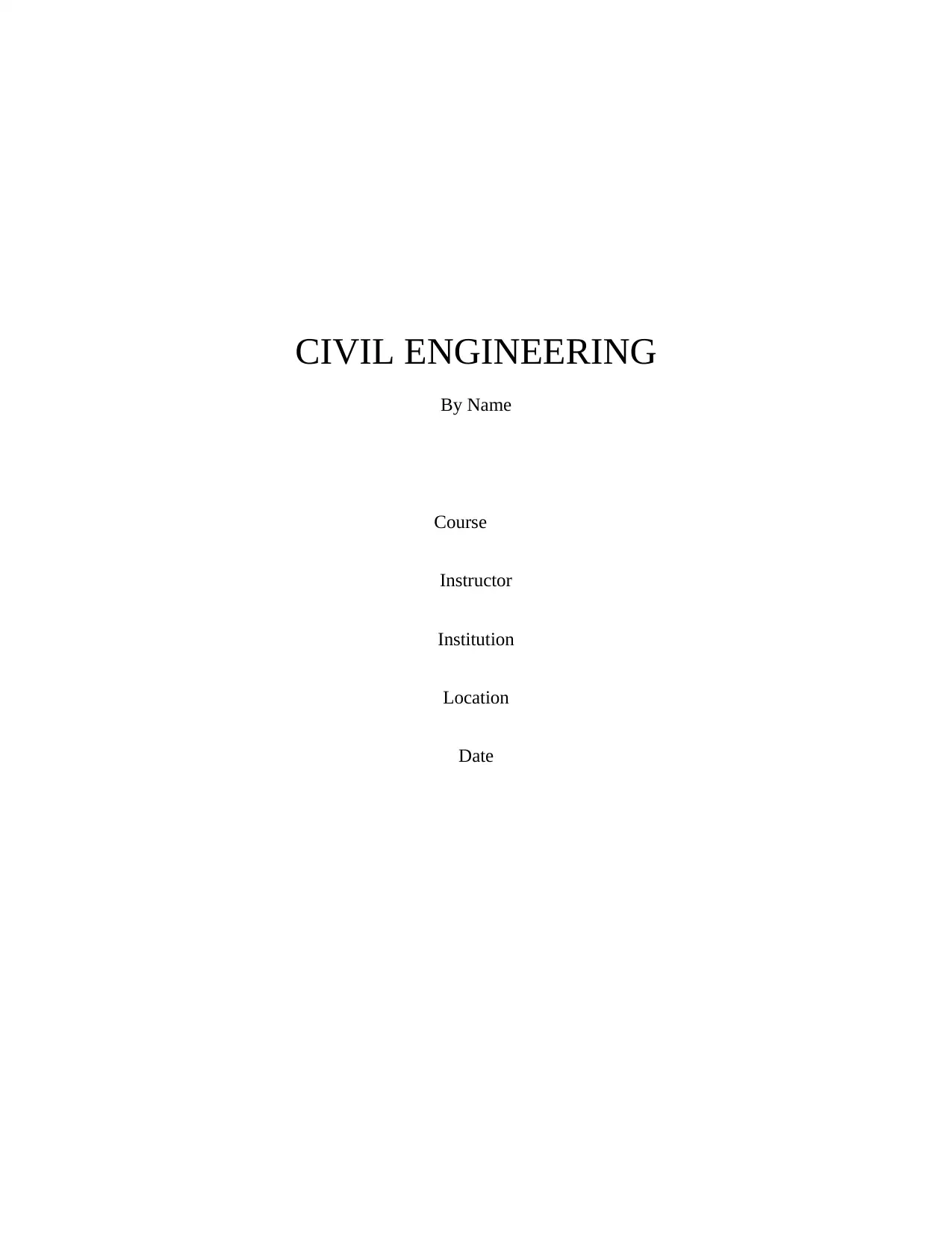
CIVIL ENGINEERING
By Name
Course
Instructor
Institution
Location
Date
By Name
Course
Instructor
Institution
Location
Date
Paraphrase This Document
Need a fresh take? Get an instant paraphrase of this document with our AI Paraphraser
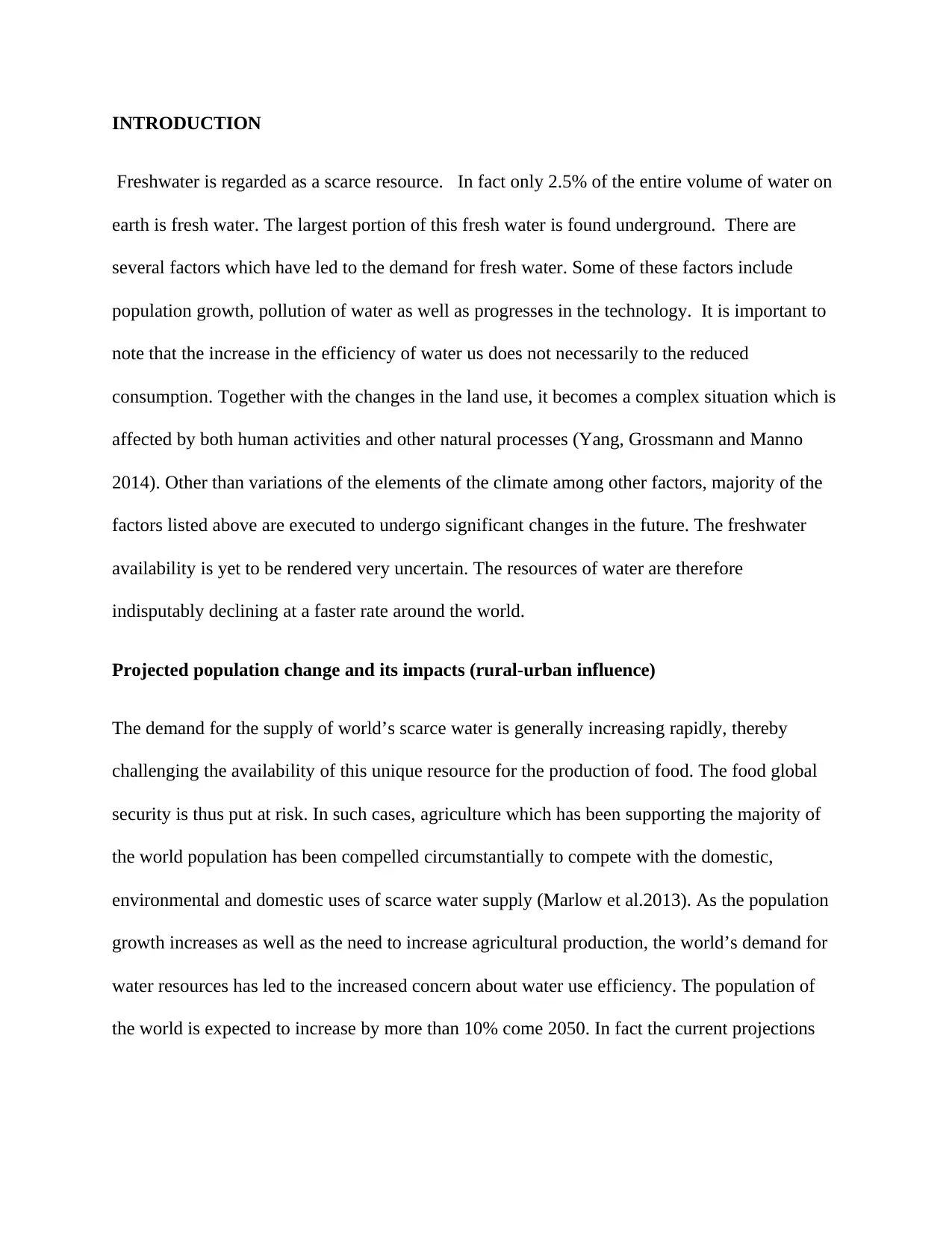
INTRODUCTION
Freshwater is regarded as a scarce resource. In fact only 2.5% of the entire volume of water on
earth is fresh water. The largest portion of this fresh water is found underground. There are
several factors which have led to the demand for fresh water. Some of these factors include
population growth, pollution of water as well as progresses in the technology. It is important to
note that the increase in the efficiency of water us does not necessarily to the reduced
consumption. Together with the changes in the land use, it becomes a complex situation which is
affected by both human activities and other natural processes (Yang, Grossmann and Manno
2014). Other than variations of the elements of the climate among other factors, majority of the
factors listed above are executed to undergo significant changes in the future. The freshwater
availability is yet to be rendered very uncertain. The resources of water are therefore
indisputably declining at a faster rate around the world.
Projected population change and its impacts (rural-urban influence)
The demand for the supply of world’s scarce water is generally increasing rapidly, thereby
challenging the availability of this unique resource for the production of food. The food global
security is thus put at risk. In such cases, agriculture which has been supporting the majority of
the world population has been compelled circumstantially to compete with the domestic,
environmental and domestic uses of scarce water supply (Marlow et al.2013). As the population
growth increases as well as the need to increase agricultural production, the world’s demand for
water resources has led to the increased concern about water use efficiency. The population of
the world is expected to increase by more than 10% come 2050. In fact the current projections
Freshwater is regarded as a scarce resource. In fact only 2.5% of the entire volume of water on
earth is fresh water. The largest portion of this fresh water is found underground. There are
several factors which have led to the demand for fresh water. Some of these factors include
population growth, pollution of water as well as progresses in the technology. It is important to
note that the increase in the efficiency of water us does not necessarily to the reduced
consumption. Together with the changes in the land use, it becomes a complex situation which is
affected by both human activities and other natural processes (Yang, Grossmann and Manno
2014). Other than variations of the elements of the climate among other factors, majority of the
factors listed above are executed to undergo significant changes in the future. The freshwater
availability is yet to be rendered very uncertain. The resources of water are therefore
indisputably declining at a faster rate around the world.
Projected population change and its impacts (rural-urban influence)
The demand for the supply of world’s scarce water is generally increasing rapidly, thereby
challenging the availability of this unique resource for the production of food. The food global
security is thus put at risk. In such cases, agriculture which has been supporting the majority of
the world population has been compelled circumstantially to compete with the domestic,
environmental and domestic uses of scarce water supply (Marlow et al.2013). As the population
growth increases as well as the need to increase agricultural production, the world’s demand for
water resources has led to the increased concern about water use efficiency. The population of
the world is expected to increase by more than 10% come 2050. In fact the current projections
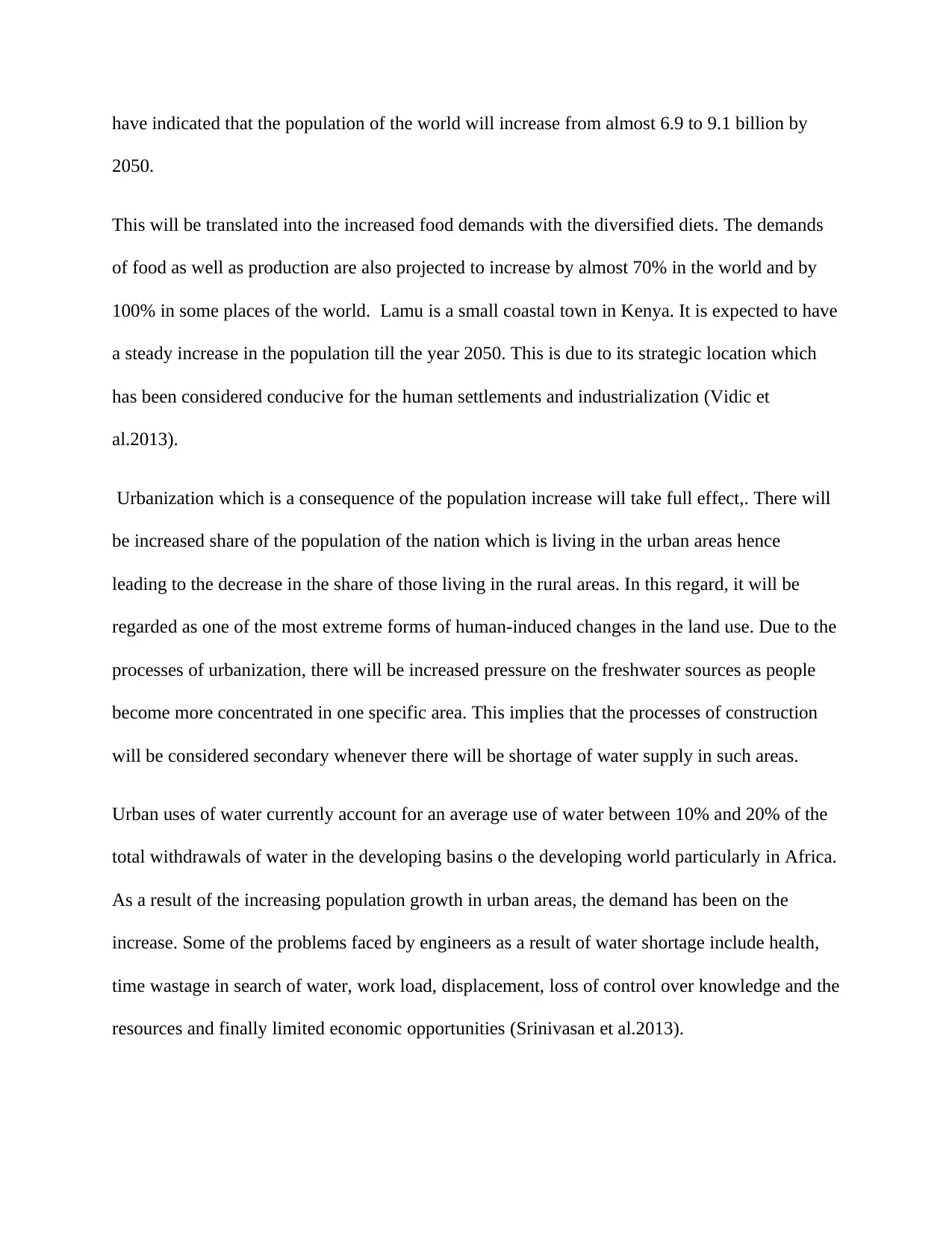
have indicated that the population of the world will increase from almost 6.9 to 9.1 billion by
2050.
This will be translated into the increased food demands with the diversified diets. The demands
of food as well as production are also projected to increase by almost 70% in the world and by
100% in some places of the world. Lamu is a small coastal town in Kenya. It is expected to have
a steady increase in the population till the year 2050. This is due to its strategic location which
has been considered conducive for the human settlements and industrialization (Vidic et
al.2013).
Urbanization which is a consequence of the population increase will take full effect,. There will
be increased share of the population of the nation which is living in the urban areas hence
leading to the decrease in the share of those living in the rural areas. In this regard, it will be
regarded as one of the most extreme forms of human-induced changes in the land use. Due to the
processes of urbanization, there will be increased pressure on the freshwater sources as people
become more concentrated in one specific area. This implies that the processes of construction
will be considered secondary whenever there will be shortage of water supply in such areas.
Urban uses of water currently account for an average use of water between 10% and 20% of the
total withdrawals of water in the developing basins o the developing world particularly in Africa.
As a result of the increasing population growth in urban areas, the demand has been on the
increase. Some of the problems faced by engineers as a result of water shortage include health,
time wastage in search of water, work load, displacement, loss of control over knowledge and the
resources and finally limited economic opportunities (Srinivasan et al.2013).
2050.
This will be translated into the increased food demands with the diversified diets. The demands
of food as well as production are also projected to increase by almost 70% in the world and by
100% in some places of the world. Lamu is a small coastal town in Kenya. It is expected to have
a steady increase in the population till the year 2050. This is due to its strategic location which
has been considered conducive for the human settlements and industrialization (Vidic et
al.2013).
Urbanization which is a consequence of the population increase will take full effect,. There will
be increased share of the population of the nation which is living in the urban areas hence
leading to the decrease in the share of those living in the rural areas. In this regard, it will be
regarded as one of the most extreme forms of human-induced changes in the land use. Due to the
processes of urbanization, there will be increased pressure on the freshwater sources as people
become more concentrated in one specific area. This implies that the processes of construction
will be considered secondary whenever there will be shortage of water supply in such areas.
Urban uses of water currently account for an average use of water between 10% and 20% of the
total withdrawals of water in the developing basins o the developing world particularly in Africa.
As a result of the increasing population growth in urban areas, the demand has been on the
increase. Some of the problems faced by engineers as a result of water shortage include health,
time wastage in search of water, work load, displacement, loss of control over knowledge and the
resources and finally limited economic opportunities (Srinivasan et al.2013).
⊘ This is a preview!⊘
Do you want full access?
Subscribe today to unlock all pages.

Trusted by 1+ million students worldwide
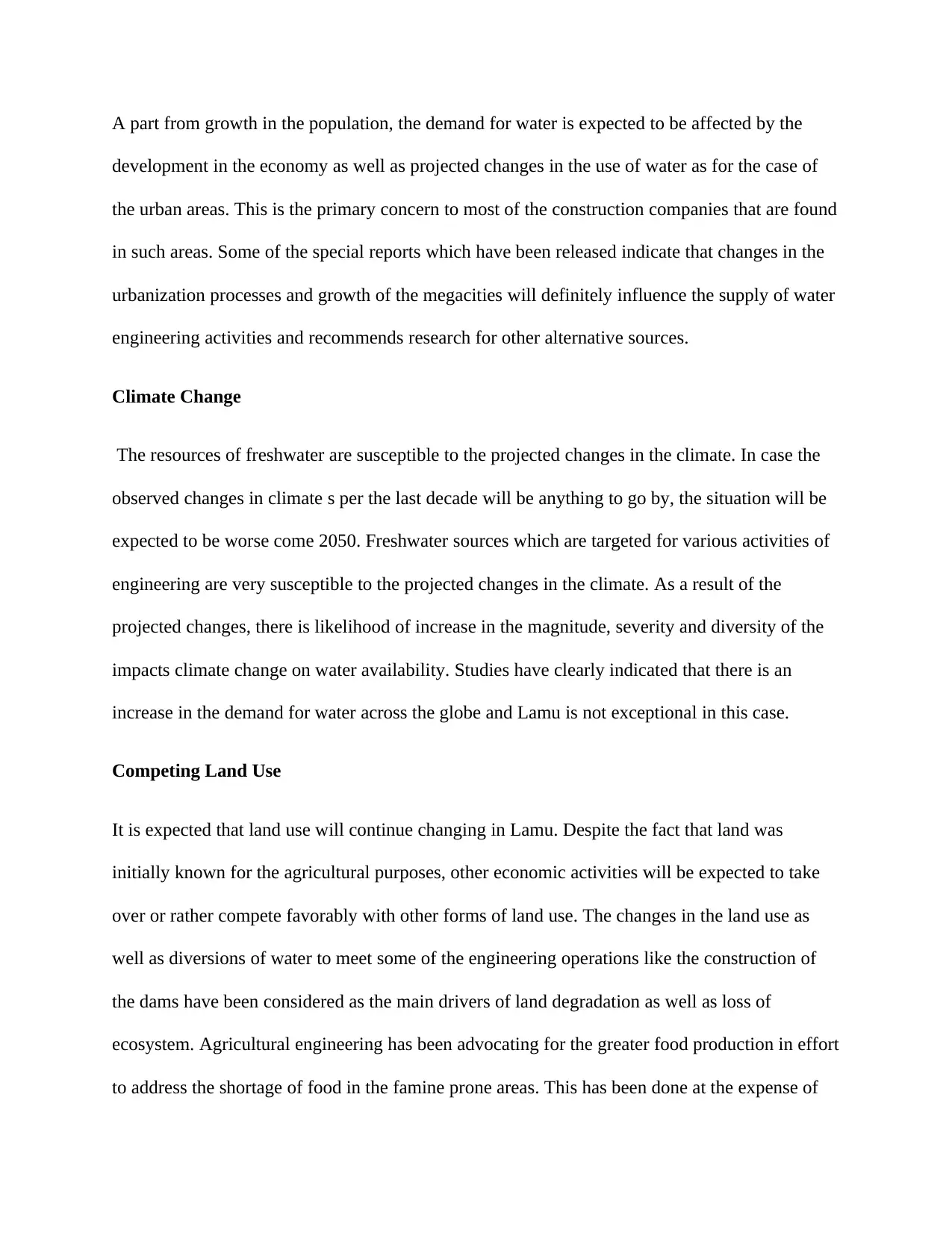
A part from growth in the population, the demand for water is expected to be affected by the
development in the economy as well as projected changes in the use of water as for the case of
the urban areas. This is the primary concern to most of the construction companies that are found
in such areas. Some of the special reports which have been released indicate that changes in the
urbanization processes and growth of the megacities will definitely influence the supply of water
engineering activities and recommends research for other alternative sources.
Climate Change
The resources of freshwater are susceptible to the projected changes in the climate. In case the
observed changes in climate s per the last decade will be anything to go by, the situation will be
expected to be worse come 2050. Freshwater sources which are targeted for various activities of
engineering are very susceptible to the projected changes in the climate. As a result of the
projected changes, there is likelihood of increase in the magnitude, severity and diversity of the
impacts climate change on water availability. Studies have clearly indicated that there is an
increase in the demand for water across the globe and Lamu is not exceptional in this case.
Competing Land Use
It is expected that land use will continue changing in Lamu. Despite the fact that land was
initially known for the agricultural purposes, other economic activities will be expected to take
over or rather compete favorably with other forms of land use. The changes in the land use as
well as diversions of water to meet some of the engineering operations like the construction of
the dams have been considered as the main drivers of land degradation as well as loss of
ecosystem. Agricultural engineering has been advocating for the greater food production in effort
to address the shortage of food in the famine prone areas. This has been done at the expense of
development in the economy as well as projected changes in the use of water as for the case of
the urban areas. This is the primary concern to most of the construction companies that are found
in such areas. Some of the special reports which have been released indicate that changes in the
urbanization processes and growth of the megacities will definitely influence the supply of water
engineering activities and recommends research for other alternative sources.
Climate Change
The resources of freshwater are susceptible to the projected changes in the climate. In case the
observed changes in climate s per the last decade will be anything to go by, the situation will be
expected to be worse come 2050. Freshwater sources which are targeted for various activities of
engineering are very susceptible to the projected changes in the climate. As a result of the
projected changes, there is likelihood of increase in the magnitude, severity and diversity of the
impacts climate change on water availability. Studies have clearly indicated that there is an
increase in the demand for water across the globe and Lamu is not exceptional in this case.
Competing Land Use
It is expected that land use will continue changing in Lamu. Despite the fact that land was
initially known for the agricultural purposes, other economic activities will be expected to take
over or rather compete favorably with other forms of land use. The changes in the land use as
well as diversions of water to meet some of the engineering operations like the construction of
the dams have been considered as the main drivers of land degradation as well as loss of
ecosystem. Agricultural engineering has been advocating for the greater food production in effort
to address the shortage of food in the famine prone areas. This has been done at the expense of
Paraphrase This Document
Need a fresh take? Get an instant paraphrase of this document with our AI Paraphraser
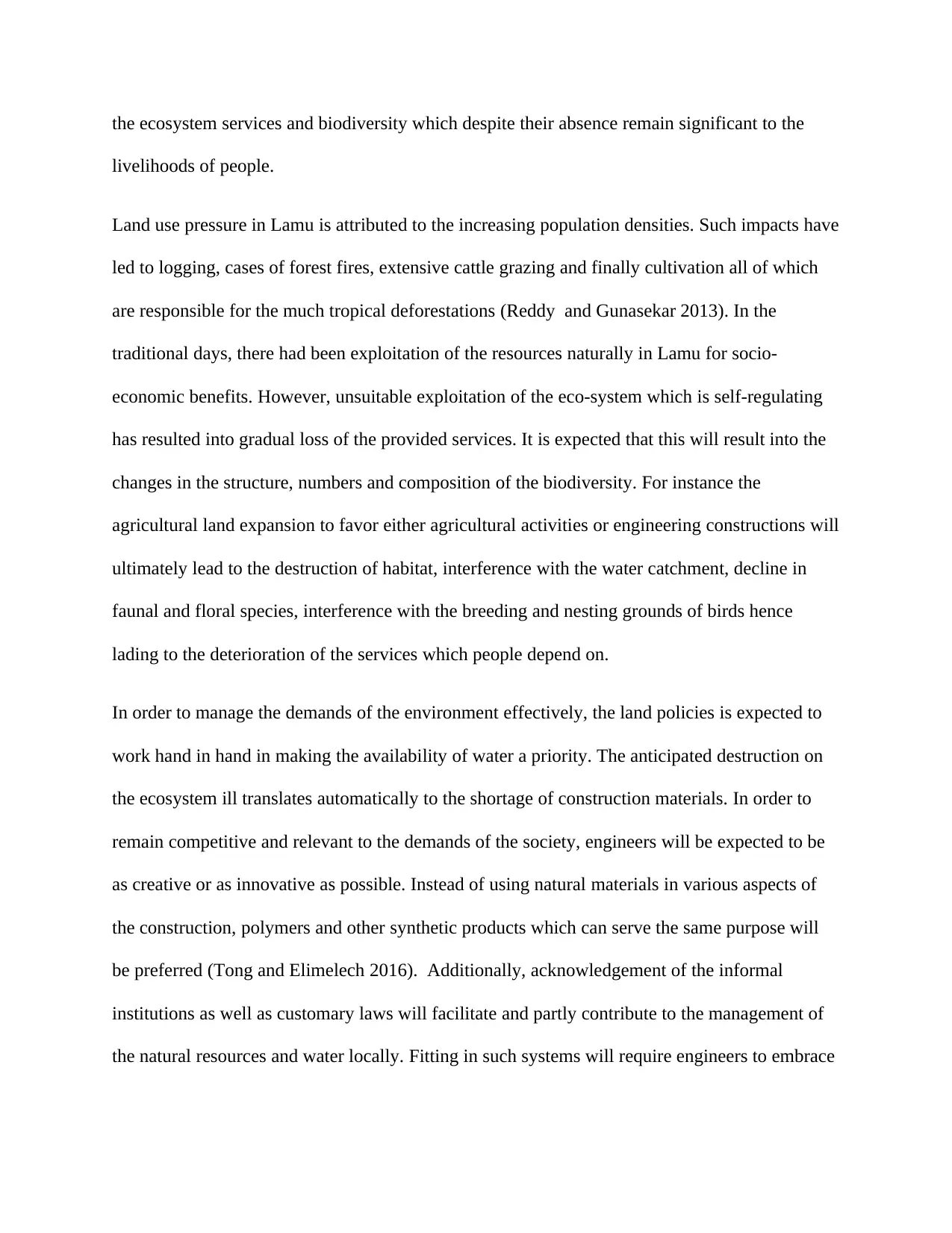
the ecosystem services and biodiversity which despite their absence remain significant to the
livelihoods of people.
Land use pressure in Lamu is attributed to the increasing population densities. Such impacts have
led to logging, cases of forest fires, extensive cattle grazing and finally cultivation all of which
are responsible for the much tropical deforestations (Reddy and Gunasekar 2013). In the
traditional days, there had been exploitation of the resources naturally in Lamu for socio-
economic benefits. However, unsuitable exploitation of the eco-system which is self-regulating
has resulted into gradual loss of the provided services. It is expected that this will result into the
changes in the structure, numbers and composition of the biodiversity. For instance the
agricultural land expansion to favor either agricultural activities or engineering constructions will
ultimately lead to the destruction of habitat, interference with the water catchment, decline in
faunal and floral species, interference with the breeding and nesting grounds of birds hence
lading to the deterioration of the services which people depend on.
In order to manage the demands of the environment effectively, the land policies is expected to
work hand in hand in making the availability of water a priority. The anticipated destruction on
the ecosystem ill translates automatically to the shortage of construction materials. In order to
remain competitive and relevant to the demands of the society, engineers will be expected to be
as creative or as innovative as possible. Instead of using natural materials in various aspects of
the construction, polymers and other synthetic products which can serve the same purpose will
be preferred (Tong and Elimelech 2016). Additionally, acknowledgement of the informal
institutions as well as customary laws will facilitate and partly contribute to the management of
the natural resources and water locally. Fitting in such systems will require engineers to embrace
livelihoods of people.
Land use pressure in Lamu is attributed to the increasing population densities. Such impacts have
led to logging, cases of forest fires, extensive cattle grazing and finally cultivation all of which
are responsible for the much tropical deforestations (Reddy and Gunasekar 2013). In the
traditional days, there had been exploitation of the resources naturally in Lamu for socio-
economic benefits. However, unsuitable exploitation of the eco-system which is self-regulating
has resulted into gradual loss of the provided services. It is expected that this will result into the
changes in the structure, numbers and composition of the biodiversity. For instance the
agricultural land expansion to favor either agricultural activities or engineering constructions will
ultimately lead to the destruction of habitat, interference with the water catchment, decline in
faunal and floral species, interference with the breeding and nesting grounds of birds hence
lading to the deterioration of the services which people depend on.
In order to manage the demands of the environment effectively, the land policies is expected to
work hand in hand in making the availability of water a priority. The anticipated destruction on
the ecosystem ill translates automatically to the shortage of construction materials. In order to
remain competitive and relevant to the demands of the society, engineers will be expected to be
as creative or as innovative as possible. Instead of using natural materials in various aspects of
the construction, polymers and other synthetic products which can serve the same purpose will
be preferred (Tong and Elimelech 2016). Additionally, acknowledgement of the informal
institutions as well as customary laws will facilitate and partly contribute to the management of
the natural resources and water locally. Fitting in such systems will require engineers to embrace
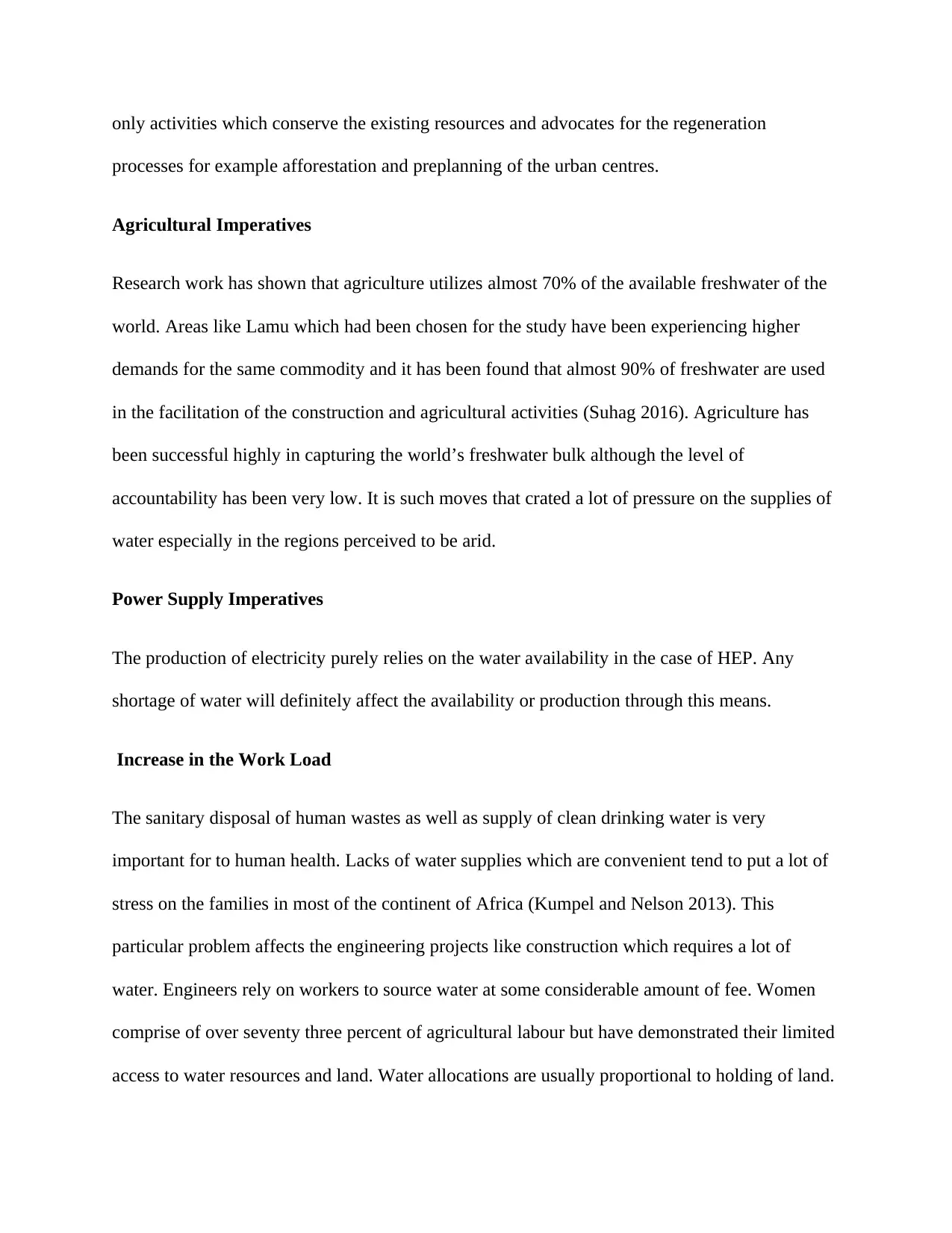
only activities which conserve the existing resources and advocates for the regeneration
processes for example afforestation and preplanning of the urban centres.
Agricultural Imperatives
Research work has shown that agriculture utilizes almost 70% of the available freshwater of the
world. Areas like Lamu which had been chosen for the study have been experiencing higher
demands for the same commodity and it has been found that almost 90% of freshwater are used
in the facilitation of the construction and agricultural activities (Suhag 2016). Agriculture has
been successful highly in capturing the world’s freshwater bulk although the level of
accountability has been very low. It is such moves that crated a lot of pressure on the supplies of
water especially in the regions perceived to be arid.
Power Supply Imperatives
The production of electricity purely relies on the water availability in the case of HEP. Any
shortage of water will definitely affect the availability or production through this means.
Increase in the Work Load
The sanitary disposal of human wastes as well as supply of clean drinking water is very
important for to human health. Lacks of water supplies which are convenient tend to put a lot of
stress on the families in most of the continent of Africa (Kumpel and Nelson 2013). This
particular problem affects the engineering projects like construction which requires a lot of
water. Engineers rely on workers to source water at some considerable amount of fee. Women
comprise of over seventy three percent of agricultural labour but have demonstrated their limited
access to water resources and land. Water allocations are usually proportional to holding of land.
processes for example afforestation and preplanning of the urban centres.
Agricultural Imperatives
Research work has shown that agriculture utilizes almost 70% of the available freshwater of the
world. Areas like Lamu which had been chosen for the study have been experiencing higher
demands for the same commodity and it has been found that almost 90% of freshwater are used
in the facilitation of the construction and agricultural activities (Suhag 2016). Agriculture has
been successful highly in capturing the world’s freshwater bulk although the level of
accountability has been very low. It is such moves that crated a lot of pressure on the supplies of
water especially in the regions perceived to be arid.
Power Supply Imperatives
The production of electricity purely relies on the water availability in the case of HEP. Any
shortage of water will definitely affect the availability or production through this means.
Increase in the Work Load
The sanitary disposal of human wastes as well as supply of clean drinking water is very
important for to human health. Lacks of water supplies which are convenient tend to put a lot of
stress on the families in most of the continent of Africa (Kumpel and Nelson 2013). This
particular problem affects the engineering projects like construction which requires a lot of
water. Engineers rely on workers to source water at some considerable amount of fee. Women
comprise of over seventy three percent of agricultural labour but have demonstrated their limited
access to water resources and land. Water allocations are usually proportional to holding of land.
⊘ This is a preview!⊘
Do you want full access?
Subscribe today to unlock all pages.

Trusted by 1+ million students worldwide
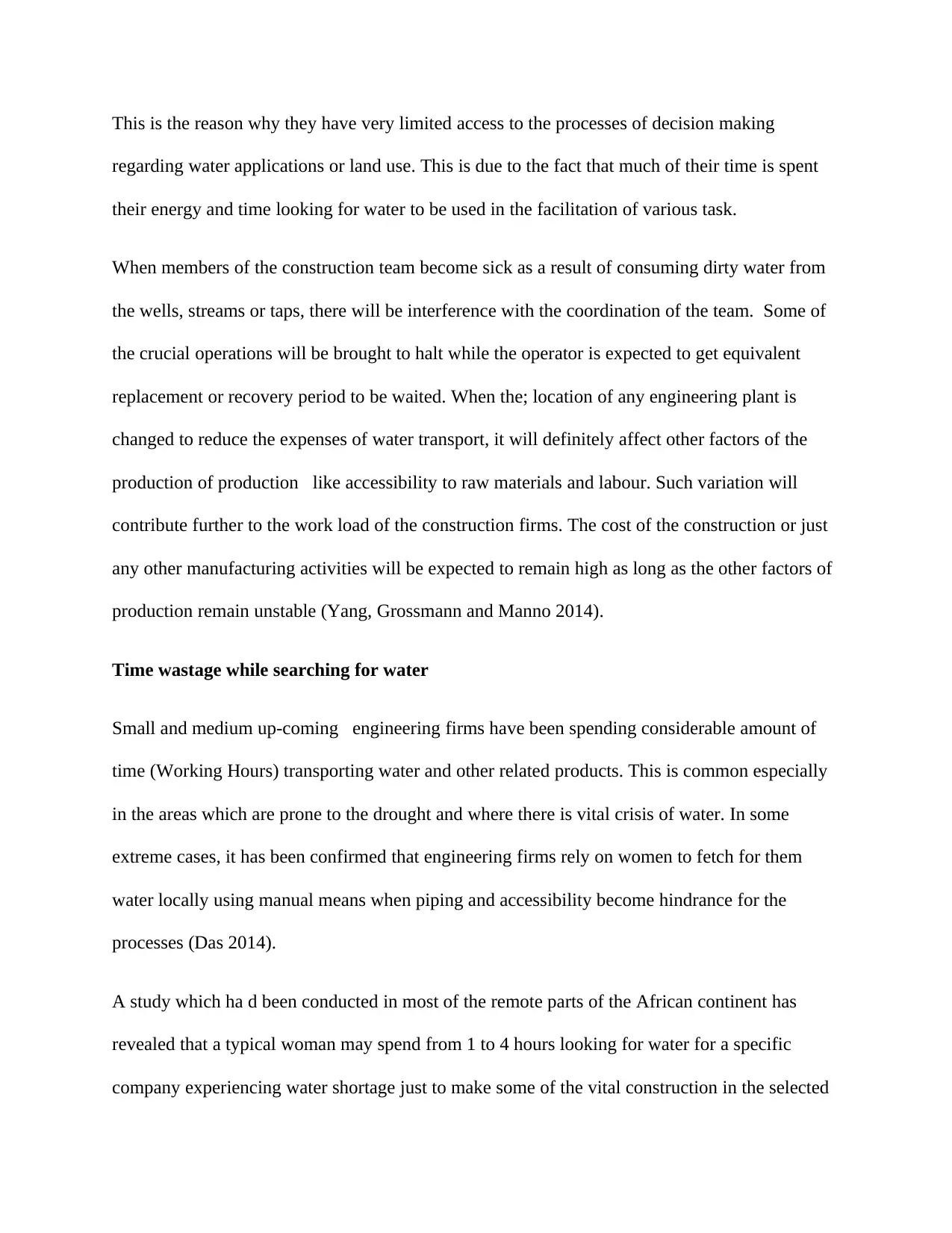
This is the reason why they have very limited access to the processes of decision making
regarding water applications or land use. This is due to the fact that much of their time is spent
their energy and time looking for water to be used in the facilitation of various task.
When members of the construction team become sick as a result of consuming dirty water from
the wells, streams or taps, there will be interference with the coordination of the team. Some of
the crucial operations will be brought to halt while the operator is expected to get equivalent
replacement or recovery period to be waited. When the; location of any engineering plant is
changed to reduce the expenses of water transport, it will definitely affect other factors of the
production of production like accessibility to raw materials and labour. Such variation will
contribute further to the work load of the construction firms. The cost of the construction or just
any other manufacturing activities will be expected to remain high as long as the other factors of
production remain unstable (Yang, Grossmann and Manno 2014).
Time wastage while searching for water
Small and medium up-coming engineering firms have been spending considerable amount of
time (Working Hours) transporting water and other related products. This is common especially
in the areas which are prone to the drought and where there is vital crisis of water. In some
extreme cases, it has been confirmed that engineering firms rely on women to fetch for them
water locally using manual means when piping and accessibility become hindrance for the
processes (Das 2014).
A study which ha d been conducted in most of the remote parts of the African continent has
revealed that a typical woman may spend from 1 to 4 hours looking for water for a specific
company experiencing water shortage just to make some of the vital construction in the selected
regarding water applications or land use. This is due to the fact that much of their time is spent
their energy and time looking for water to be used in the facilitation of various task.
When members of the construction team become sick as a result of consuming dirty water from
the wells, streams or taps, there will be interference with the coordination of the team. Some of
the crucial operations will be brought to halt while the operator is expected to get equivalent
replacement or recovery period to be waited. When the; location of any engineering plant is
changed to reduce the expenses of water transport, it will definitely affect other factors of the
production of production like accessibility to raw materials and labour. Such variation will
contribute further to the work load of the construction firms. The cost of the construction or just
any other manufacturing activities will be expected to remain high as long as the other factors of
production remain unstable (Yang, Grossmann and Manno 2014).
Time wastage while searching for water
Small and medium up-coming engineering firms have been spending considerable amount of
time (Working Hours) transporting water and other related products. This is common especially
in the areas which are prone to the drought and where there is vital crisis of water. In some
extreme cases, it has been confirmed that engineering firms rely on women to fetch for them
water locally using manual means when piping and accessibility become hindrance for the
processes (Das 2014).
A study which ha d been conducted in most of the remote parts of the African continent has
revealed that a typical woman may spend from 1 to 4 hours looking for water for a specific
company experiencing water shortage just to make some of the vital construction in the selected
Paraphrase This Document
Need a fresh take? Get an instant paraphrase of this document with our AI Paraphraser
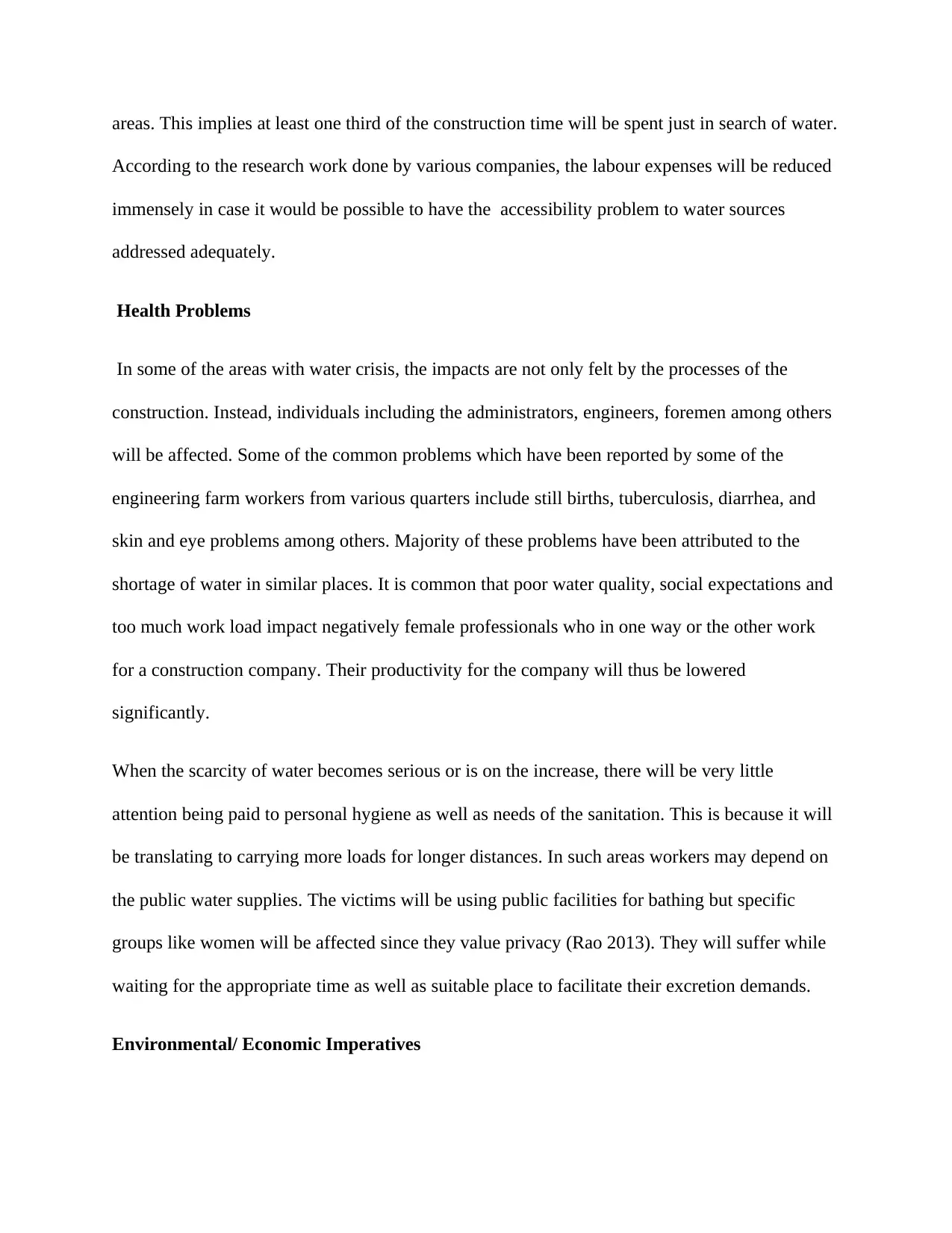
areas. This implies at least one third of the construction time will be spent just in search of water.
According to the research work done by various companies, the labour expenses will be reduced
immensely in case it would be possible to have the accessibility problem to water sources
addressed adequately.
Health Problems
In some of the areas with water crisis, the impacts are not only felt by the processes of the
construction. Instead, individuals including the administrators, engineers, foremen among others
will be affected. Some of the common problems which have been reported by some of the
engineering farm workers from various quarters include still births, tuberculosis, diarrhea, and
skin and eye problems among others. Majority of these problems have been attributed to the
shortage of water in similar places. It is common that poor water quality, social expectations and
too much work load impact negatively female professionals who in one way or the other work
for a construction company. Their productivity for the company will thus be lowered
significantly.
When the scarcity of water becomes serious or is on the increase, there will be very little
attention being paid to personal hygiene as well as needs of the sanitation. This is because it will
be translating to carrying more loads for longer distances. In such areas workers may depend on
the public water supplies. The victims will be using public facilities for bathing but specific
groups like women will be affected since they value privacy (Rao 2013). They will suffer while
waiting for the appropriate time as well as suitable place to facilitate their excretion demands.
Environmental/ Economic Imperatives
According to the research work done by various companies, the labour expenses will be reduced
immensely in case it would be possible to have the accessibility problem to water sources
addressed adequately.
Health Problems
In some of the areas with water crisis, the impacts are not only felt by the processes of the
construction. Instead, individuals including the administrators, engineers, foremen among others
will be affected. Some of the common problems which have been reported by some of the
engineering farm workers from various quarters include still births, tuberculosis, diarrhea, and
skin and eye problems among others. Majority of these problems have been attributed to the
shortage of water in similar places. It is common that poor water quality, social expectations and
too much work load impact negatively female professionals who in one way or the other work
for a construction company. Their productivity for the company will thus be lowered
significantly.
When the scarcity of water becomes serious or is on the increase, there will be very little
attention being paid to personal hygiene as well as needs of the sanitation. This is because it will
be translating to carrying more loads for longer distances. In such areas workers may depend on
the public water supplies. The victims will be using public facilities for bathing but specific
groups like women will be affected since they value privacy (Rao 2013). They will suffer while
waiting for the appropriate time as well as suitable place to facilitate their excretion demands.
Environmental/ Economic Imperatives
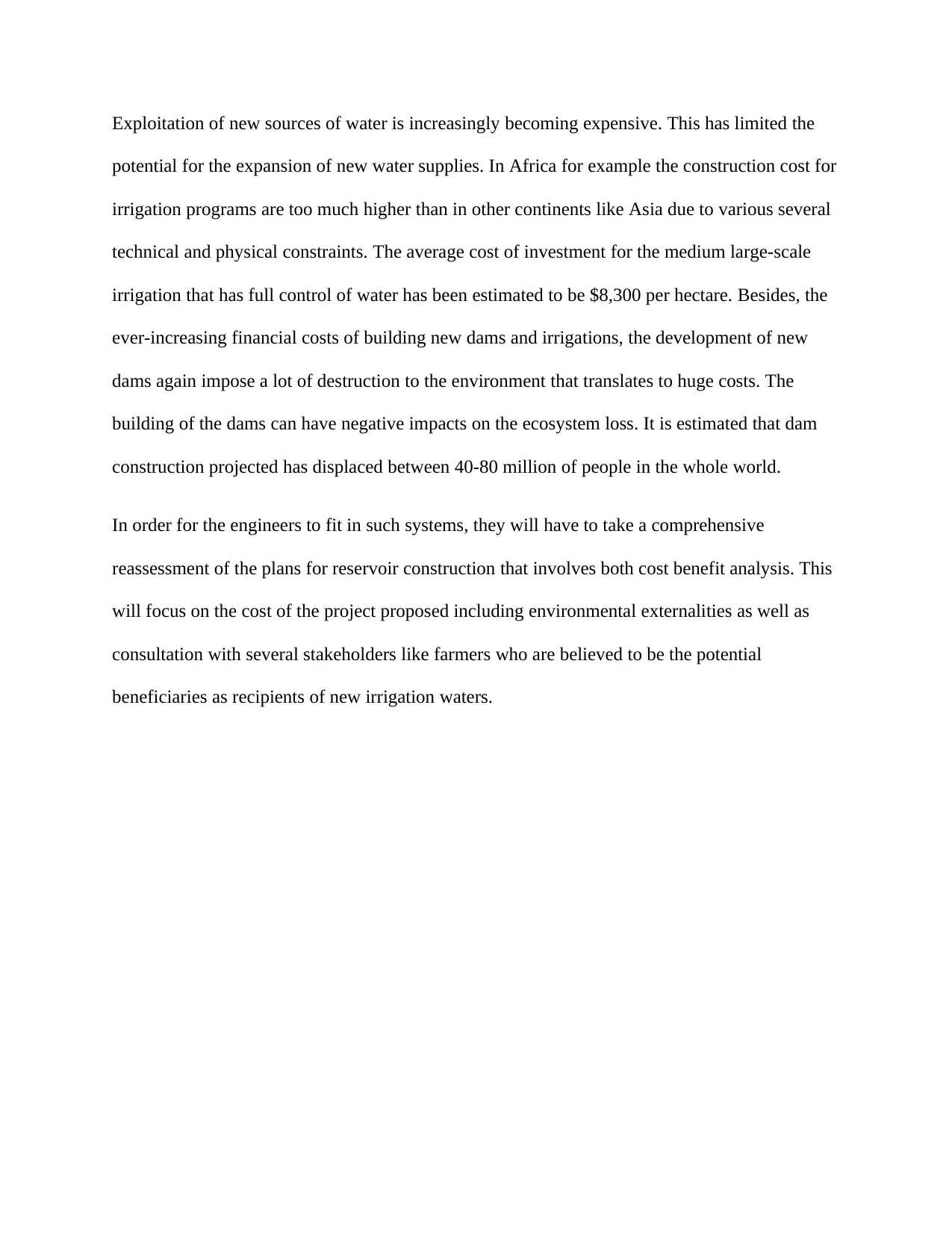
Exploitation of new sources of water is increasingly becoming expensive. This has limited the
potential for the expansion of new water supplies. In Africa for example the construction cost for
irrigation programs are too much higher than in other continents like Asia due to various several
technical and physical constraints. The average cost of investment for the medium large-scale
irrigation that has full control of water has been estimated to be $8,300 per hectare. Besides, the
ever-increasing financial costs of building new dams and irrigations, the development of new
dams again impose a lot of destruction to the environment that translates to huge costs. The
building of the dams can have negative impacts on the ecosystem loss. It is estimated that dam
construction projected has displaced between 40-80 million of people in the whole world.
In order for the engineers to fit in such systems, they will have to take a comprehensive
reassessment of the plans for reservoir construction that involves both cost benefit analysis. This
will focus on the cost of the project proposed including environmental externalities as well as
consultation with several stakeholders like farmers who are believed to be the potential
beneficiaries as recipients of new irrigation waters.
potential for the expansion of new water supplies. In Africa for example the construction cost for
irrigation programs are too much higher than in other continents like Asia due to various several
technical and physical constraints. The average cost of investment for the medium large-scale
irrigation that has full control of water has been estimated to be $8,300 per hectare. Besides, the
ever-increasing financial costs of building new dams and irrigations, the development of new
dams again impose a lot of destruction to the environment that translates to huge costs. The
building of the dams can have negative impacts on the ecosystem loss. It is estimated that dam
construction projected has displaced between 40-80 million of people in the whole world.
In order for the engineers to fit in such systems, they will have to take a comprehensive
reassessment of the plans for reservoir construction that involves both cost benefit analysis. This
will focus on the cost of the project proposed including environmental externalities as well as
consultation with several stakeholders like farmers who are believed to be the potential
beneficiaries as recipients of new irrigation waters.
⊘ This is a preview!⊘
Do you want full access?
Subscribe today to unlock all pages.

Trusted by 1+ million students worldwide
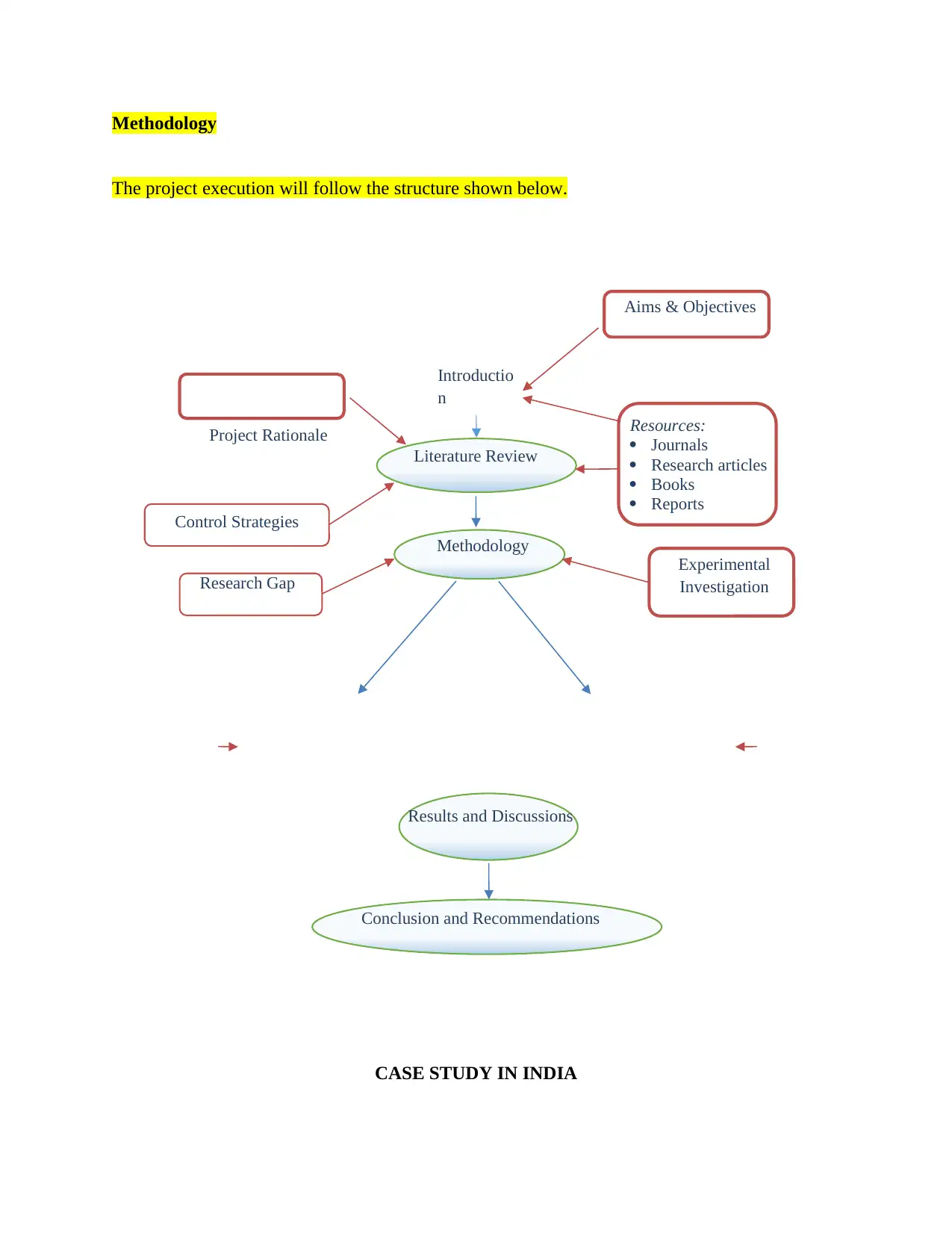
Methodology
The project execution will follow the structure shown below.
CASE STUDY IN INDIA
Introductio
n
Literature Review
Methodology
Conclusion and Recommendations
Results and Discussions
Aims & Objectives
Resources:
Journals
Research articles
Books
Reports
Project Rationale
Experimental
Investigation
Control Strategies
Research Gap
The project execution will follow the structure shown below.
CASE STUDY IN INDIA
Introductio
n
Literature Review
Methodology
Conclusion and Recommendations
Results and Discussions
Aims & Objectives
Resources:
Journals
Research articles
Books
Reports
Project Rationale
Experimental
Investigation
Control Strategies
Research Gap
Paraphrase This Document
Need a fresh take? Get an instant paraphrase of this document with our AI Paraphraser
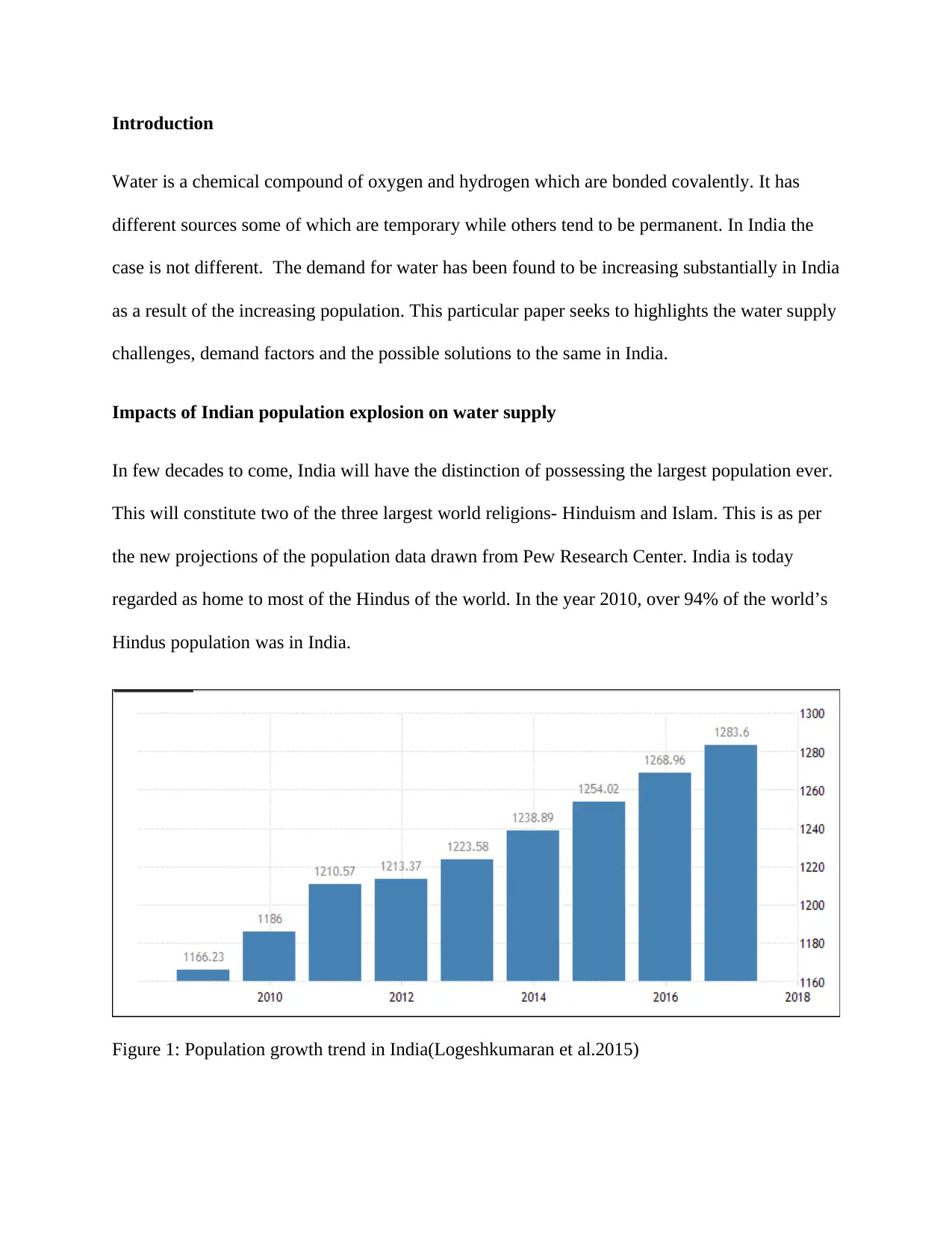
Introduction
Water is a chemical compound of oxygen and hydrogen which are bonded covalently. It has
different sources some of which are temporary while others tend to be permanent. In India the
case is not different. The demand for water has been found to be increasing substantially in India
as a result of the increasing population. This particular paper seeks to highlights the water supply
challenges, demand factors and the possible solutions to the same in India.
Impacts of Indian population explosion on water supply
In few decades to come, India will have the distinction of possessing the largest population ever.
This will constitute two of the three largest world religions- Hinduism and Islam. This is as per
the new projections of the population data drawn from Pew Research Center. India is today
regarded as home to most of the Hindus of the world. In the year 2010, over 94% of the world’s
Hindus population was in India.
Figure 1: Population growth trend in India(Logeshkumaran et al.2015)
Water is a chemical compound of oxygen and hydrogen which are bonded covalently. It has
different sources some of which are temporary while others tend to be permanent. In India the
case is not different. The demand for water has been found to be increasing substantially in India
as a result of the increasing population. This particular paper seeks to highlights the water supply
challenges, demand factors and the possible solutions to the same in India.
Impacts of Indian population explosion on water supply
In few decades to come, India will have the distinction of possessing the largest population ever.
This will constitute two of the three largest world religions- Hinduism and Islam. This is as per
the new projections of the population data drawn from Pew Research Center. India is today
regarded as home to most of the Hindus of the world. In the year 2010, over 94% of the world’s
Hindus population was in India.
Figure 1: Population growth trend in India(Logeshkumaran et al.2015)
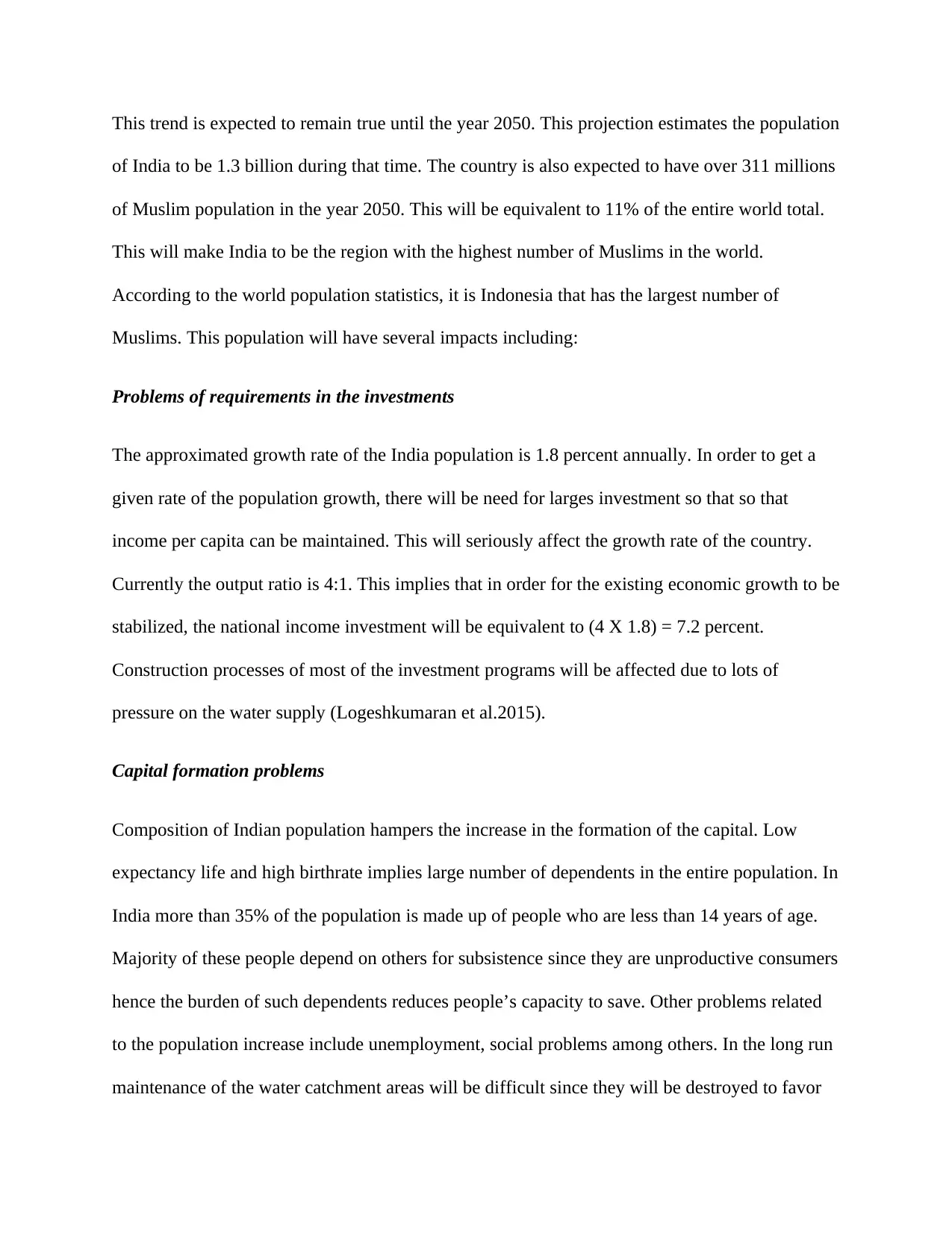
This trend is expected to remain true until the year 2050. This projection estimates the population
of India to be 1.3 billion during that time. The country is also expected to have over 311 millions
of Muslim population in the year 2050. This will be equivalent to 11% of the entire world total.
This will make India to be the region with the highest number of Muslims in the world.
According to the world population statistics, it is Indonesia that has the largest number of
Muslims. This population will have several impacts including:
Problems of requirements in the investments
The approximated growth rate of the India population is 1.8 percent annually. In order to get a
given rate of the population growth, there will be need for larges investment so that so that
income per capita can be maintained. This will seriously affect the growth rate of the country.
Currently the output ratio is 4:1. This implies that in order for the existing economic growth to be
stabilized, the national income investment will be equivalent to (4 X 1.8) = 7.2 percent.
Construction processes of most of the investment programs will be affected due to lots of
pressure on the water supply (Logeshkumaran et al.2015).
Capital formation problems
Composition of Indian population hampers the increase in the formation of the capital. Low
expectancy life and high birthrate implies large number of dependents in the entire population. In
India more than 35% of the population is made up of people who are less than 14 years of age.
Majority of these people depend on others for subsistence since they are unproductive consumers
hence the burden of such dependents reduces people’s capacity to save. Other problems related
to the population increase include unemployment, social problems among others. In the long run
maintenance of the water catchment areas will be difficult since they will be destroyed to favor
of India to be 1.3 billion during that time. The country is also expected to have over 311 millions
of Muslim population in the year 2050. This will be equivalent to 11% of the entire world total.
This will make India to be the region with the highest number of Muslims in the world.
According to the world population statistics, it is Indonesia that has the largest number of
Muslims. This population will have several impacts including:
Problems of requirements in the investments
The approximated growth rate of the India population is 1.8 percent annually. In order to get a
given rate of the population growth, there will be need for larges investment so that so that
income per capita can be maintained. This will seriously affect the growth rate of the country.
Currently the output ratio is 4:1. This implies that in order for the existing economic growth to be
stabilized, the national income investment will be equivalent to (4 X 1.8) = 7.2 percent.
Construction processes of most of the investment programs will be affected due to lots of
pressure on the water supply (Logeshkumaran et al.2015).
Capital formation problems
Composition of Indian population hampers the increase in the formation of the capital. Low
expectancy life and high birthrate implies large number of dependents in the entire population. In
India more than 35% of the population is made up of people who are less than 14 years of age.
Majority of these people depend on others for subsistence since they are unproductive consumers
hence the burden of such dependents reduces people’s capacity to save. Other problems related
to the population increase include unemployment, social problems among others. In the long run
maintenance of the water catchment areas will be difficult since they will be destroyed to favor
⊘ This is a preview!⊘
Do you want full access?
Subscribe today to unlock all pages.

Trusted by 1+ million students worldwide
1 out of 23
Related Documents
Your All-in-One AI-Powered Toolkit for Academic Success.
+13062052269
info@desklib.com
Available 24*7 on WhatsApp / Email
![[object Object]](/_next/static/media/star-bottom.7253800d.svg)
Unlock your academic potential
Copyright © 2020–2025 A2Z Services. All Rights Reserved. Developed and managed by ZUCOL.





